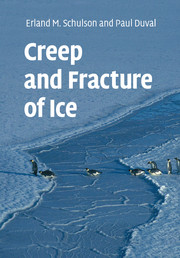Book contents
- Frontmatter
- Contents
- Preface
- Acknowledgements
- 1 Introduction
- 2 Structure of ice
- 3 Microstructure of natural ice features
- 4 Physical properties: elasticity, friction and diffusivity
- 5 Plastic deformation of the ice single crystal
- 6 Ductile behavior of polycrystalline ice: experimental data and physical processes
- 7 Modeling the ductile behavior of isotropic and anisotropic polycrystalline ice
- 8 Rheology of high-pressure and planetary ices
- 9 Fracture toughness of ice
- 10 Brittle failure of ice under tension
- 11 Brittle compressive failure of unconfined ice
- 12 Brittle compressive failure of confined ice
- 13 Ductile-to-brittle transition under compression
- 14 Indentation fracture and ice forces on structures
- 15 Fracture of the ice cover on the Arctic Ocean
- Index
- References
14 - Indentation fracture and ice forces on structures
Published online by Cambridge University Press: 01 February 2010
- Frontmatter
- Contents
- Preface
- Acknowledgements
- 1 Introduction
- 2 Structure of ice
- 3 Microstructure of natural ice features
- 4 Physical properties: elasticity, friction and diffusivity
- 5 Plastic deformation of the ice single crystal
- 6 Ductile behavior of polycrystalline ice: experimental data and physical processes
- 7 Modeling the ductile behavior of isotropic and anisotropic polycrystalline ice
- 8 Rheology of high-pressure and planetary ices
- 9 Fracture toughness of ice
- 10 Brittle failure of ice under tension
- 11 Brittle compressive failure of unconfined ice
- 12 Brittle compressive failure of confined ice
- 13 Ductile-to-brittle transition under compression
- 14 Indentation fracture and ice forces on structures
- 15 Fracture of the ice cover on the Arctic Ocean
- Index
- References
Summary
Introduction
We turn now to the indentation of ice. This kind of deformation can occur, for instance, during the interaction between a floating ice feature and a bridge pier or an offshore platform. In those situations and others like them, the primary issue is the interaction force. If too high, the structure will fail, as exemplified by the lighthouse shown inFigure 14.1. The limiting load is set by the compressive strength of the ice and, as noted in Chapter 11, can exceed the 100-year wave force (API, 1995).
Ice loading per se is beyond the scope of this book. Loading has been discussed by Sanderson (1988), who provides an account of a variety of field studies, and more recently by Bazant (2001), Blanchet and Defranco (2001), Jordaan (2001), Jordaan and Pond (2001), Masterson and Spencer (2001), Palmer and Johnston (2001), Sodhi (2001), Takeuchi et al. (2001), Tuhkuri (2001), Timco and Johnston (2003, 2004) and Frederking and Sudom (2006). Ice loading is discussed also in a report by the American Petroleum Institute (API, 1995) and more recently by the Canadian Standards Association Code (see Masterson and Frederking, 2006), by the International Standards Organization (Blanchet et al., 2007) and by Masterson et al. (2007).
Our objective is to consider the physical processes that underlie indentation failure. The process is a complicated one.
- Type
- Chapter
- Information
- Creep and Fracture of Ice , pp. 336 - 360Publisher: Cambridge University PressPrint publication year: 2009



